The quest for longevity has always been a cornerstone of human curiosity. Among the myriad of diets and lifestyles that promise a longer, healthier life, the Blue Zone Diet stands out. Rooted in regions where people live significantly longer than the global average, this diet holds the secrets of centenarians from distinct parts of the world. However, the success of this diet revolves around 10 main rules. Let’s find out what they are and more!
Genetic ancestry tests are becoming increasingly popular. While your DNA can be used to learn about your roots, did you know that it influences how well you respond to diet, what nutrients you need the most, your weight loss tendencies, etc? This allows you to craft a diet best suited for your body so that you can achieve your dietary goals. You can upload your DNA data to learn 1,500+ things about your health. Learn more.
Blue zones are locations all over the world where people live significantly longer.
The name comes from the blue circles researchers drew around these places on the map when they first identified them.
These locations are across Europe, Asia, and North and Central America.
Inhabitants of these blue zones don’t suffer from heart disease, cancer, or diabetes and often go on to live for over 100 years.
Diet and lifestyle seem to play a massive role in increasing the lifespan of people in these places.
The five blue zones are:
The blue zone diet is an eating plan followed by people living in these locations.
The hallmarks of this diet are:
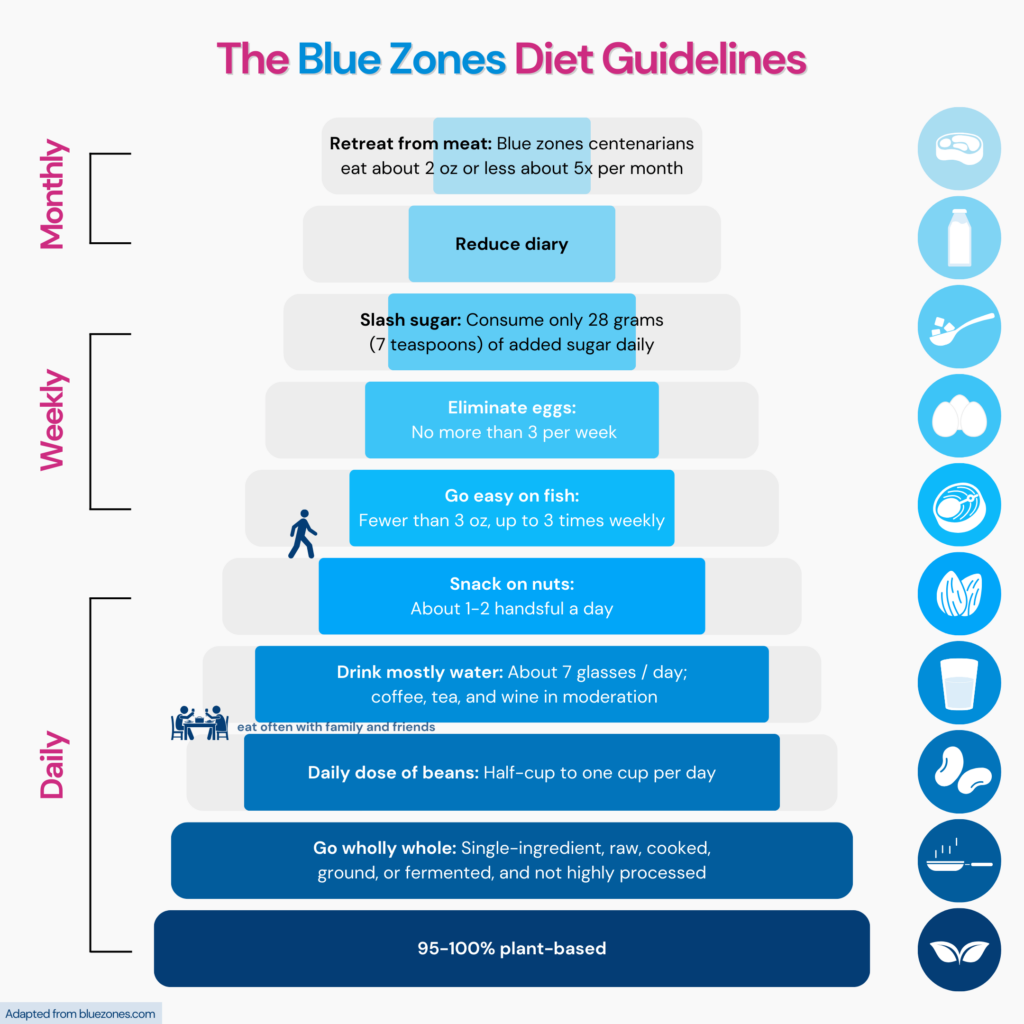
The blue zone diet focuses on consuming fresh fruits, vegetables, and whole grains while limiting processed foods.
Here are the best foods to include in your meals if you are following this diet:
Two of the five blue zones lie in the Mediterranean region.
The blue zone diet has a lot of similarities with the Mediterranean diet.
Like the Mediterranean this diet also includes fresh fruits and vegetables and is low on meat and dairy.
Both types of diets focus on having a balanced approach toward food rather than eliminating entire food groups.
The blue zone diet is not necessarily designed for weight loss.
It mainly focuses on helping you live longer.
However, when you start making healthier food choices and eating only nutritious meals, chances are you will start losing excess weight.
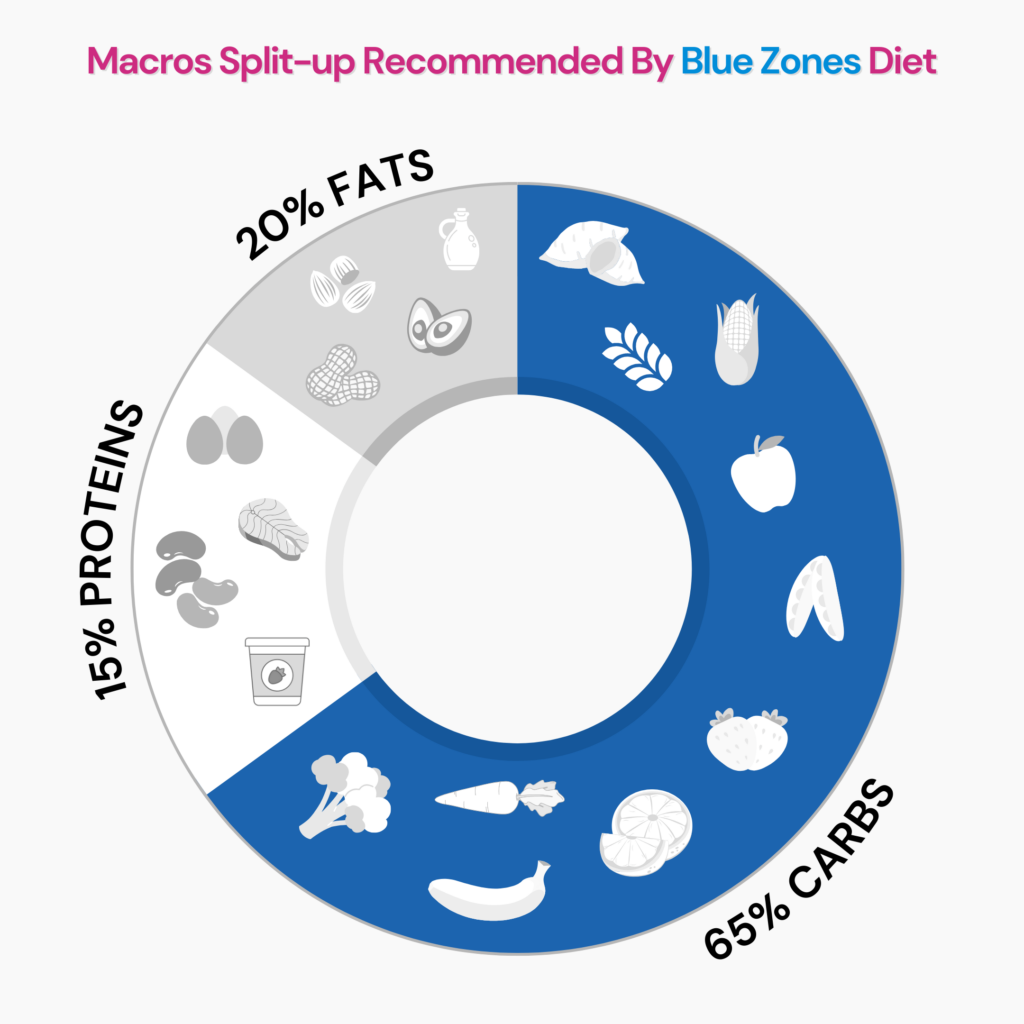
Besides diet, researchers have found that people in the blue zones practice other healthy habits, such as:
The blue zone diet is found in some regions where people live significantly longer lives.
These areas are all over Central and Latin America, Europe and Asia.
People in these zones eat a primarily plant-based diet.
This diet includes fresh fruits, vegetables, whole grains, legumes, beans and nuts.
It also excludes processed food, sugar, and dairy.
People in the blue zones don’t suffer from common lifestyle disorders like obesity and diabetes.
Since the blue zone diet reduces inflammation and free radical damage, it reduces the risk of developing cancer.
Apart from a healthy diet, people in the blue zones practice healthy habits such as belonging to a community and not living a sedentary lifestyle.
All these factors collectively make the blue zone diet a longevity booster.
https://www.everydayhealth.com/diet-nutrition/the-blue-zone-diet-a-complete-scientific-guide/
https://www.verywellhealth.com/blue-zone-diet-foods-4159314
https://www.healthline.com/nutrition/blue-zone-diets
https://www.verywellhealth.com/can-barley-lower-your-cholesterol-697944
Why can some individuals run faster, jump higher, or endure longer than others? Hard work, training, and determination? Yes, of course, they do play a big role. But behind this athletic superpower lies another secret entity: the ACTN3 gene. This gene plays a significant role in influencing athletic performance. But here’s the twist: people carry different types of this gene, each of which supports different athletic parameters. Read on to understand the deep-rooted connection between the ACTN3 gene and your athletic performance.
Genetic ancestry tests are becoming increasingly popular. While your DNA can be used to learn about your roots, did you know that it can also reveal important things about your health risks and wellness aspects? This allows you to take proactive measures for health conditions, even before the symptoms appear, thereby preventing it. You can upload your DNA data to learn 1,500+ things about your health. Learn more.
The ACTN3 gene provides instructions to produce the alpha-actinin-3 protein present in fast-twitch muscle fibers.
Fast-twitch muscle fibers contract quickly and help perform high-intensity activities for short intervals.
Fast-twitch muscle fibers rely on anaerobic respiration for muscle contraction.
The ACTN3 gene can have variants, which is quite common among the general population.
About 20-30% of the general population have this mutation.
It usually does not have any harmful effects on general health and well-being.
However, the genotype of the ACTN3 gene can affect one's athletic performance.
Skeletal muscles are attached to the bones and help in movement.
Each functional unit of a skeletal muscle is called a sarcomere.
The sarcomere is made of two types of filaments: actin and myosin.
The ACTN3 gene encodes the alpha-actinin three proteins.
It is found in fast-twitch muscle fibers.
The fast twitch muscle fibers produce powerful, explosive bursts of speed.
Such powerful muscle contractions are needed in deadlifting, sprinting, and speed skating.
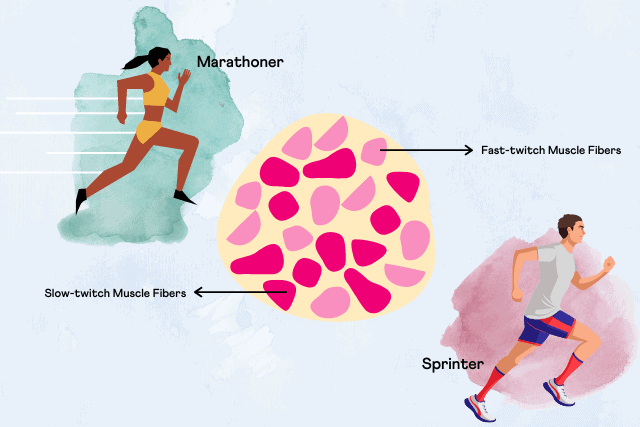
ACTN3 gene can have a variant or mutated form.
Those without the variation have the genotype R/R, while those with the mutation can have either R/X or X/X genotype.
The ACTN3 gene's genotype determines the composition of the fast twitch muscle fiber.
The presence of either the R/R, R/X, or X/X genotype determines the amount of alpha-actinin-3 protein present in the fast-twitch muscle.
The ACTN3 genotype and an individual's athletic performance are linked in the following way:
ACTN3 gene is only expressed in fast twitch muscles and is essential for anchoring actin.
It also regulates the coordination of muscle fiber contraction.
The R/R and R/X genotype of the ACTN3 gene is associated with sprint performance, while the X/X genotype is associated with endurance performance.
The ACTN3 gene encodes the alpha-actinin-3 protein.
This protein is found in fast-twitch muscle fibers and generates explosive muscle power.
Several studies have shown the presence of the R/R genotype in sprint athletes.
The R/R genotype of the ACTN3 gene is associated with explosive muscle power, while the X/X genotype is associated with less muscle power.
Notably, the R/X genotype showed no association with power athlete status.
Damage to skeletal muscles from a sudden, intense workout is called exercise-induced muscle damage.
It is more common in people who are not accustomed to regular exercise.
Exercise-induced muscle damage is accompanied by delayed onset muscle soreness and leakage of intramuscular proteins into the blood.
Individuals with the X/X genotype are more prone to experience exercise-induced muscle damage than those with the R/R genotype.
Studies show that such individuals had higher serum markers of muscle damage after working out.
Is delayed onset muscle soreness a sign of muscle growth?
Handgrip strength is often used to measure muscular fitness.
Higher grip strength indicates better recovery after a fracture and lowered grip strength is often associated with old age.
The Actn3 KO mice mimic the X/X genotype of the ACTN3 gene in humans.
Studies have shown that the Actn3 KO mice have significantly lower grip strength and increased recovery from fatigue.
This pattern is very similar to what is seen in human muscles deficient in the ACTN3 gene.
Everyone has two copies of the ACTN3 gene.
One is the working copy, which produces a protein called 577R, and the other is the non-working copy called 577X.
The more working copies of the ACTN3 gene you have, the better your athletic performance.
So, if you have the R/R genotype of the ACTN3 gene from both of your biological parents, you are likely to be a good athlete.
If neither of your parents had a working copy of the gene, you likely have the X/X genotype of the ACTN3 gene.
Athletic performance can be strongly influenced by genetics.
But it cannot necessarily predict success.
Having the sprinter gene in your cells does not mean you will be an elite sprinter.
It just means that you will perform better in sprint or power events.
You still need to undergo optimal training to achieve success as a sprinter.
It also means that you need to work harder as an endurance athlete.
Psychological and environmental factors influence athletic performance.
Optimal nutritional practices often compensate for not having the athletic gene.
People with the R/R and R/X genotypes who have high strength and power should ideally choose high-load-low-repetition workouts.
On the other hand, people with the X/X genotype should choose workouts with low load and high repetition.
Individuals with the R/R or R/X genotype are more resistant to muscle damage and should choose high-intensity intermittent training.
Individuals with the X/X genotype should go with low-intensity, high-volume training.
A simple blood test can reveal if you have a functioning copy of the ACTN3 gene.
You will need our doctor's prescription and valid identity proof to undergo the test.
The test report is usually delivered within eight days of collecting the blood sample.
The ACTN3 gene encodes a protein and is found in fast-twitch muscle fibers.
It is associated with sudden explosive muscle power and is said to influence athletic performance.
The ACTN3 gene has three variations: R/R, R/X and X/X.
The R/R genotype is associated with more muscle power and handgrip strength, while the X/X genotype is associated with more muscle damage during exercise.
Having the ACTN3 gene means that you might be a good sprinter.
You still need to undergo training and practice to succeed as an athlete.
Proper training, nutrition, and the ACTN3 gene will help you succeed as an athlete.
https://www.sciencedirect.com/topics/biochemistry-genetics-and-molecular-biology/actn3
https://www.ncbi.nlm.nih.gov/pmc/articles/PMC5741991/
https://www.ncbi.nlm.nih.gov/pmc/articles/PMC7404684/
https://pubmed.ncbi.nlm.nih.gov/28154975/
https://www.ncbi.nlm.nih.gov/pmc/articles/PMC3784532/
https://www.ncbi.nlm.nih.gov/pmc/articles/PMC4624116/.
A type of inflammatory bowel disease, Crohn’s disease, can affect any part of the digestive tract. Although it commonly affects individuals in their late teens or early 20s, it can develop at any age affecting men and women equally.
Several risk factors have been identified to influence Crohn’s disease, including environmental and genetic factors.
This article will discuss how genetics can affect your risk of developing Crohn’s disease.
Did You Know? Your ancestry test DNA data includes 700,000 markers, which can be used to learn everything from disease risk and drug sensitivities to nutritional requirements and fitness parameters. Learn more.
Studies have shown that around 15% of the individuals affected by Crohn’s disease have an immediately affected relative.
Some environmental factors like diet, alcohol consumption, and smoking also influence.
Mutations in some genes on chromosomes 5 and 10 are linked to Crohn’s disease.
Notably, ATG16L1, IL23R, IRGM, and NOD2 genes appear to increase the risk of developing Crohn’s disease.
Mutations in the above genes affect gut bacteria which in turn affects the ability of the intestinal cells to respond to it. This leads to symptoms of inflammation and digestive issues associated with Crohn’s disease.
Around 3 million adults reported being diagnosed with either Crohn’s disease or ulcerative colitis as of 2015 in the United States.
Crohn’s disease is becoming increasingly common in children for unknown reasons.
Some symptoms of Crohn’s disease to be aware of include:
As with any complex condition, Crohn’s disease cannot be diagnosed effectively using a single test. A mixture of tests like a biopsy, radiological scan, blood tests, computerized tomography (CT) scan, and magnetic resonance imaging (MRI) can be used to diagnose Crohn’s disease.
Prenatal genetic testing for mutations in the NOD2 gene is also done for pregnant women. Finding a mutation in this gene does not necessarily indicate a diagnosis of Crohn’s disease. It only shows an increased risk of developing the disease.
There is no known cure for Crohn’s disease. The main objective for treatment is the relief of symptoms and disease remission. Remission is when you don’t feel any noticeable symptoms of the disease.
Remission can last from days to years and varies between individuals.
Treatment of Crohn’s disease involves a combination of drugs and sometimes surgery. Antibiotics, biologics, anti-inflammatory drugs, immune system suppressors, diet, and more are potential therapies that your healthcare team may recommend.
Happiness is a universal human desire but can be elusive and hard to measure. How do we define happiness, and how does it change throughout our lives? At what age are people happiest? What factors influence our happiness, and how can we increase it? Continue reading to explore these questions, based on a new study examining the relationship between age and happiness. We will also share some proven psychological strategies for increasing your happiness, regardless of age.
Happiness is a complex and subjective phenomenon, influenced by many factors such as genetics, personality, culture, life events, health, income, social relationships, and more.
However, one factor that has received a lot of attention from researchers is age.
Various studies have explored the impact of age on happiness.
Some suggest that happiness follows a U-shaped curve, meaning that people are happier in their 20s and old age but less happy in their middle age.
Others point out that happiness declines with age as people face more challenges and losses.
Still, many argue that happiness increases with age as people gain more wisdom and perspective.
Whether children are happier than adults doesn't have a straightforward answer.
According to a research review, the happiness of children and teenagers aged 6-18 is significantly influenced by cohesion and family communication.
Good familial relationships and effective communication are vital in promoting a happy and healthy family environment.
This means that when children grow up in supportive and friendly families, they tend to be happier.
Family functioning isn't only essential for children and adults regarding happiness. Functional family dynamics can enhance the well-being of everyone in the family.
Additionally, children may have some happiness advantages over adults.
They typically face fewer stressors related to work and finances and enjoy more opportunities for play and leisure, contributing to their happiness.
It's crucial to remember that not all children are privileged to grow up in such supportive environments.
Children who experience abuse, neglect, or other forms of trauma are at a higher risk of facing mental health challenges and lower happiness levels.
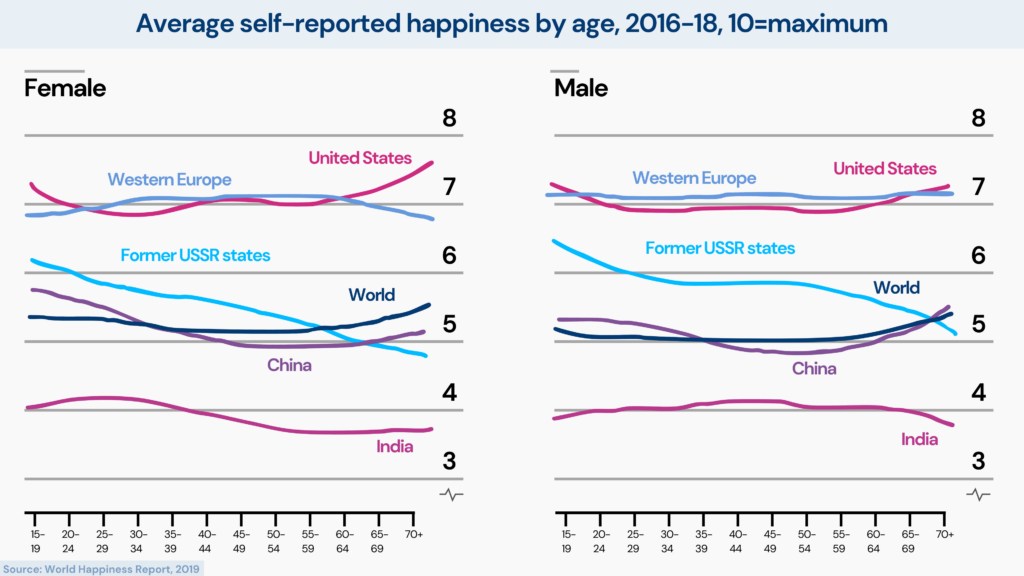
According to a study published in the journal Psychological Bulletin in 2023, researchers comprehensively examined subjective well-being (SWB) across the lifespan.
Their primary objective was to address the question of at what age people are happiest.
This study analyzed a vast dataset consisting of 443 samples from longitudinal studies, involving a staggering total of 460,902 participants.
The focus assessed changes in three fundamental components of SWB:
The study's enormous scope allowed researchers to draw meaningful insights from a diverse and extensive pool of participants.
These participants spanned various age groups and life stages, contributing to the depth and reliability of the findings.
This extensive research shed light on the intricate relationship between age and happiness. Here are the key takeaways:
Despite the fluctuations, the study indicated a positive trend in life satisfaction and negative emotional states over a significant portion of life.
As individuals navigate various life stages, their ability to find happiness and cope with negative emotions may improve.
While this study shows valuable insights into the relationship between age and happiness, it's essential to acknowledge its limitations:
The above study showed that happiness is not determined by age alone but by many other factors that our choices and actions can influence.
Therefore, we can increase our happiness by adopting some proven psychological strategies that have been shown to enhance well-being.
Here are 5 examples:
Happiness is complex and influenced by age, with varying research findings.
Children's happiness relates to family dynamics, especially support and communication.
A study revealed that happiness in life follows a distinctive pattern over a lifetime.
It declines in adolescence, increases until around age 70, and then undergoes a shift.
Positive emotions also change with age, while negative emotions show different patterns.
To boost happiness, practice gratitude, meditate, build meaningful relationships, set goals, and engage in acts of kindness.
https://www.ncbi.nlm.nih.gov/pmc/articles/PMC7529452/
https://www.mdpi.com/1660-4601/19/24/16593
https://psycnet.apa.org/doiLanding?doi=10.1037%2Fbul0000401
https://www.healthline.com/health/how-to-be-happy
Move over, Dr. Google; with a new health trend every other week, Dr. TikTok is here to take your spot. The last few weeks have been all about Budget Ozempic, a new weight loss trend on TikTok. But registered nutritionists and other healthcare experts are frowning down upon this latest fad. Here’s everything you need to know about Budget Ozempic and why you probably should not consider this path to weight loss.
"Budget Ozempic" is a term that has been coined by the TikTok community, but it's fundamentally different from the medication "Ozempic," used to treat type 2 diabetes.
In essence, "Budget Ozempic" refers to the compound known as polyethylene glycol 3350 or PEG 3350 for short.
Now, PEG 3350 might sound unfamiliar, but its presence is more common than one might realize.
Chemically, this compound shares similarities with other polymers found in various everyday products - from cosmetics and soaps to paints and even missile fuel components.
PEG 3350 is a key component in laxative and stool-softening products.
Consumers might recognize it in brands such as DulcoSoft and Movicol, often referred to as macrogols.
Apart from alleviating constipation, it's also administered to patients to prepare their bowels prior to a colonoscopy.
The buzz about "Budget Ozempic" on TikTok has made many curious about how it helps with weight loss. Here's a simple breakdown.
PEG 3350 in "Budget Ozempic" is a type of laxative that pulls water into the intestines to help soften stools.
When you drink something with PEG 3350, the body doesn’t absorb this ingredient.
Instead, PEG 3350 gathers water from your body as it moves through the intestines, making your stools watery.
How does this affect weight?
Since PEG 3350 takes more water out of your body than the amount you drink, it causes a temporary drop in weight.
But it's just making you lose water, not actual body fat.
So, when you drink water next, the body quickly tries to replace what it lost, and you might gain back the weight.
For noticeable weight loss, you’d need to consume a lot of PEG 3350; even then, you’re likely to shed only a couple of pounds.
This mechanism is different from how Ozempic works to manage diabetes.
It acts like some natural hormones in our body that help manage blood sugar and weight.
These hormones slow down how fast the stomach empties, making us feel full for longer and eat less.
This can lead to real and lasting weight loss, unlike the temporary effects of PEG 3350.
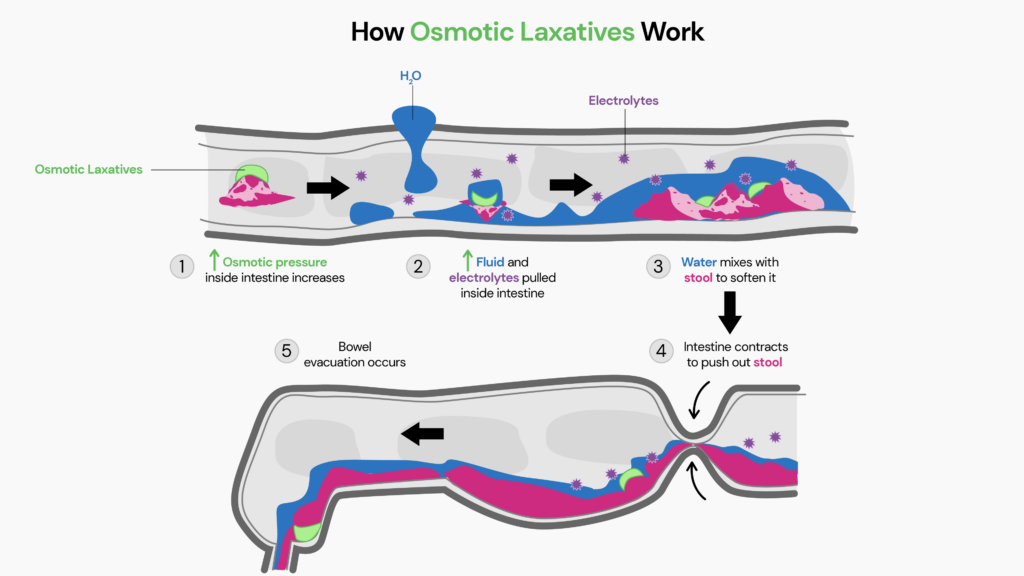
Budget Ozempic has raised eyebrows in the health community.
Many experts worry about its potential dangers, especially when used for weight loss.
Anna Mapson, a registered nutritionist, describes the trend as “really worrying.”
She emphasizes that not only are laxatives ineffective for weight loss, but they can also be quite dangerous.
She explains, “When waste products reach our large intestine, our body tries to recycle as many nutrients as possible before elimination.
By skipping this vital process with laxatives, you risk dehydration and losing too many essential minerals.
This can result in dizziness, lethargy, and even kidney disruption. Worse, continuous misuse might damage your gut and liver.”*
Tony Cottenden, a Nutritionist, also expresses his reservations: “When you speed up the movement of food through our system, our body has less time to absorb nutrients, which can lead to deficiencies affecting our overall health.
The risks aren't limited to the gut. Laxative misuse can harm both the heart and the mind. Low potassium and magnesium can lead to heart irregularities and even heart failure.
Psychologically, the temporary weight loss from laxatives can create dependence, escalating the physical risks and possibly leading to eating disorders and other mental health issues.”*
*as taken from Healthline
In the world of weight loss, going back to basics might just be the key. Here are some effective, safe, and nutritionally sound strategies to consider:
The TikTok trend "Budget Ozempic" is gaining traction for weight loss, but it's crucial to understand its implications. Predominantly, it relies on PEG 3350, a compound in laxatives, and not the diabetes medication "Ozempic." Though it might show temporary weight reduction by dehydrating the body, experts warn of numerous health risks. These include dehydration, potential heart issues, and a high salt concentration in the blood. Registered nutritionists emphasize that genuine weight loss comes from healthier habits: focusing on whole foods, boosting fiber intake, and incorporating lean proteins. As trends come and go, prioritizing long-term health over fleeting fads remains the wisest choice.
https://www.scientificamerican.com/article/budget-ozempic-weight-loss-trend-raises-safety-concerns/
https://www.healthline.com/health-news/budget-ozempic-weight-loss-trend-unsafe
https://www.medicalnewstoday.com/articles/325892
https://medlineplus.gov/druginfo/meds/a603032.html
https://www.verywellhealth.com/ozempic-semaglutide-uses-efficacy-side-effects-7489260
Amino acids are often celebrated as the essential building blocks of proteins, vital for our health and body functions. However, homocysteine stands as an exception to this general rule. If your homocysteine levels are riding high, you might be opening the door to some not-so-friendly guests like heart disease, stroke, and even chronic Alzheimer's disease. While various factors contribute to its increase, our diet remains at the forefront of these influencers. Learning what foods cause high homocysteine levels can help you plan your diet to support your health.
Did You Know? MTHFR is a key gene influencing your homocysteine levels. Certain changes in it can result in homocysteine buildup, increasing your risk for various serious health conditions. Your ancestry test DNA data contains more than 700,000 markers, which can be used to learn about your MTHFR gene and 1000+ other things about your health. Learn more.
Homocysteine is an amino acid, a chemical component in the bloodstream that helps in protein synthesis.
It is formed when the body breaks down another amino acid called methionine.
While methionine is beneficial for the body, high levels of homocysteine come with various health risks.
Vitamins such as B12, B6, and B9 (folate) may influence homocysteine levels in the blood because they help metabolize homocysteine into other essential chemicals needed by the body.
These vitamin deficiencies can result in high homocysteine levels and are linked with an increased risk for two significant health concerns:
A normal level of homocysteine in the blood is less than 15 mcmol/L (micromoles per liter).
When homocysteine levels exceed the normal limit:
High homocysteine levels can damage blood vessels by harming the lining of arteries, known as the endothelium.
This damage can make arteries more vulnerable to atherosclerosis, where plaque builds up on the artery walls.
Plaque is like a sticky substance that can narrow the arteries, reducing blood flow to essential organs like the heart and brain.
High homocysteine levels can also make the blood more likely to form clots.
These clots, also known as thrombus, can block blood vessels in the brain, heart, or lungs, leading to serious health issues as they travel through the bloodstream.
High homocysteine levels can have several negative effects on the body, including:
Consuming certain foods can raise homocysteine levels due to excess protein or methionine or by interfering with the absorption or metabolism of folate, vitamin B12, or vitamin B6. These foods include:
The MTHFR gene produces an enzyme known as methylenetetrahydrofolate reductase (MTHFR). This enzyme converts folate into its active form, 5-methyltetrahydrofolate (5-MTHF).
5-MTHF is essential for the production of methionine, which is a building block of proteins.
5-MTHF is used to convert homocysteine back into methionine, which helps to keep homocysteine levels in check.
People with a mutation in the MTHFR gene may have reduced MTHFR activity (may not process enough folate), which can lead to high homocysteine levels.
There are two main types of MTHFR gene mutations: C677T and A1298C. The C677T mutation is more common than the A1298C mutation.
People with one copy of the C677T mutation have a slightly increased risk of high homocysteine levels.
People with two copies of the C677T mutation have a higher risk of high homocysteine levels.
The A1298C mutation is less common than the C677T mutation but has a greater impact on MTHFR activity.
People with one copy of the A1298C mutation have a moderate risk of high homocysteine levels.
If you have two copies of the A1298C mutation, it is unlikely to cause high homocysteine levels. Other factors, such as vitamin deficiency, aging, kidney disease, or certain medications, may be responsible.
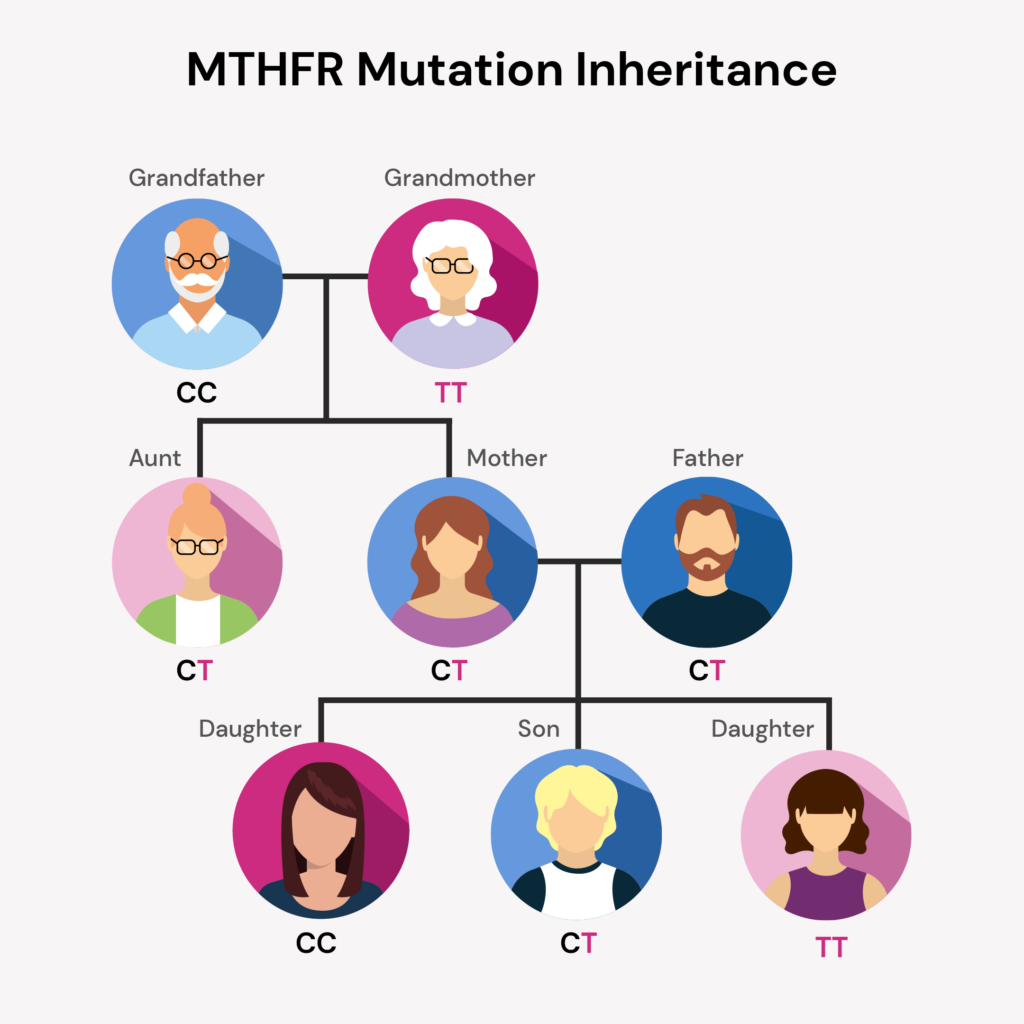
In addition to MTHFR gene mutations, several other things can contribute to high homocysteine levels, including:
According to a study published in PubMed, vitamin C may reduce homocysteine levels and help prevent vascular damage.
The study discovered that people with higher vitamin C levels tended to have lower homocysteine levels.
Interestingly, the impact of vitamin C on homocysteine was more noticeable in those with lower vitamin C levels. This suggests that vitamin C could benefit people with high homocysteine levels.
It is important to note that the study was observational, so it cannot prove that vitamin C causes homocysteine levels to lower.
More research is needed to confirm this study's findings and determine the optimal dose of vitamin C for lowering homocysteine levels.
You can naturally lower your homocysteine levels by changing your diet and lifestyle. Here are some tips to follow:
It's advisable to consult your doctor before making significant dietary changes or taking supplements. They'll guide you on the best approach.
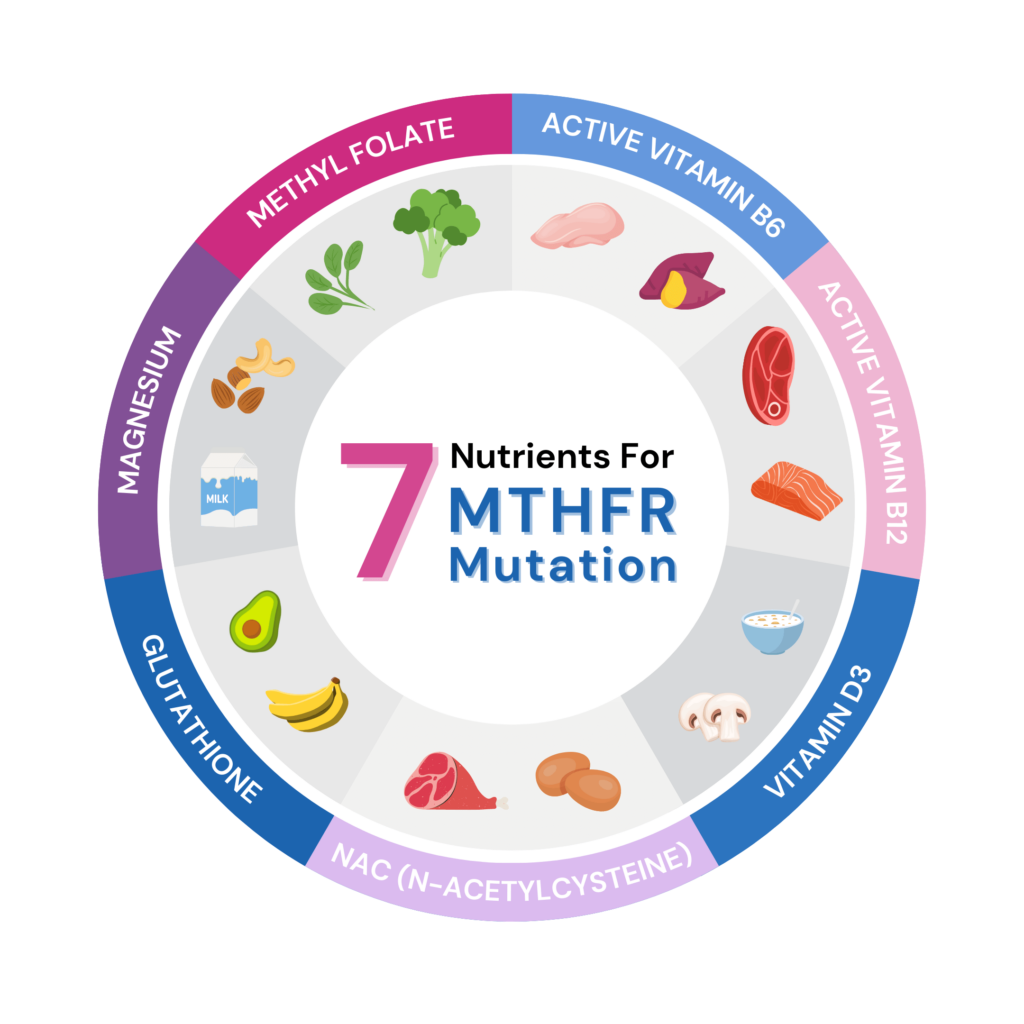
Taking folate supplements can be beneficial if you have an MTHFR gene mutation or elevated homocysteine levels.
But not every manufactured folate supplement will work for you. Synthetic folic acid may disrupt your natural folate metabolism and lead to adverse effects.
Instead, search for organic folate supplements that include methylfolate or 5-MTHF, the type your body can use or absorb easily.
As a precaution, consult with your physician before taking supplements.
High homocysteine levels can lead to health problems like heart disease, stroke, and Alzheimer's.
When methionine breaks down, it produces the amino acid homocysteine. Vitamins B12, B6, and B9 (folate) can help regulate its levels.
Elevated homocysteine levels can damage blood vessels and increase the risk of atherosclerosis and blood clotting.
It can also impact brain function, bone health, and mood.
Foods that can raise homocysteine levels include red meat, dairy products, processed foods, and alcohol.
MTHFR gene mutations can also contribute to high homocysteine levels, as this gene affects folate metabolism.
Other factors like kidney disease, hypothyroidism, certain medications, smoking, and heavy drinking can also raise homocysteine levels.
Vitamin C may help lower homocysteine levels, especially in those with lower vitamin C levels. However, more research is needed to confirm this effect.
To naturally lower homocysteine levels, one can consume folate-rich foods, vitamin B12-rich foods, and vitamin B6-rich foods.
Regular exercise and consult a doctor before making dietary changes or taking supplements are advisable.
The MTHFR and Methylation Report analyzes important variants in this gene known to lower the MTHFR enzyme levels.
If you have done an ancestry genetic test with companies like 23andMe, AncestryDNA, MyHeritage, etc., you can learn this information in 3 steps.
You can now get your ancestry DNA kits at an additional discount!
After you receive your DNA test results from the kit, you can upload your DNA data to our secure platform.
https://www.ahajournals.org/doi/full/10.1161/01.CIR.0000165142.37711.E7
https://www.healthline.com/health/homocysteine-levels
https://www.medicalnewstoday.com/articles/homocysteine-levels
https://medlineplus.gov/genetics/gene/mthfr/